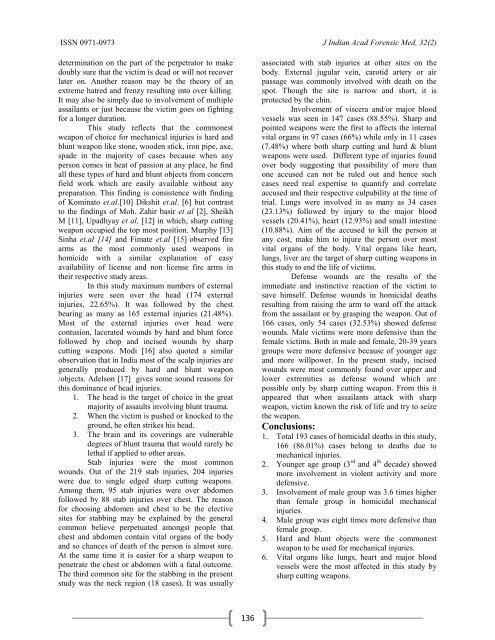jiafm, 2010-32(2) april-june. - forensic medicine
jiafm, 2010-32(2) april-june. - forensic medicine
jiafm, 2010-32(2) april-june. - forensic medicine
- No tags were found...
Create successful ePaper yourself
Turn your PDF publications into a flip-book with our unique Google optimized e-Paper software.
ISSN 0971-0973 J Indian Acad Forensic Med, <strong>32</strong>(2)determination on the part of the perpetrator to makedoubly sure that the victim is dead or will not recoverlater on. Another reason may be the theory of anextreme hatred and frenzy resulting into over killing.It may also be simply due to involvement of multipleassailants or just because the victim goes on fightingfor a longer duration.This study reflects that the commonestweapon of choice for mechanical injuries is hard andblunt weapon like stone, wooden stick, iron pipe, axe,spade in the majority of cases because when anyperson comes in heat of passion at any place, he findall these types of hard and blunt objects from concernfield work which are easily available without anypreparation. This finding is consistence with findingof Kominato et.al.[10] Dikshit et.al. [6] but contrastto the findings of Moh. Zahir basir et al [2], SheikhM [11], Upadhyay et al, [12] in which, sharp cuttingweapon occupied the top most position. Murphy [13]Sinha et.al [14] and Fimate et.al [15] observed firearms as the most commonly used weapons inhomicide with a similar explanation of easyavailability of license and non license fire arms intheir respective study areas.In this study maximum numbers of externalinjuries were seen over the head (174 externalinjuries, 22.65%). It was followed by the chestbearing as many as 165 external injuries (21.48%).Most of the external injuries over head werecontusion, lacerated wounds by hard and blunt forcefollowed by chop and incised wounds by sharpcutting weapons. Modi [16] also quoted a similarobservation that in India most of the scalp injuries aregenerally produced by hard and blunt weapon/objects. Adelson [17] gives some sound reasons forthis dominance of head injuries.1. The head is the target of choice in the greatmajority of assaults involving blunt trauma.2. When the victim is pushed or knocked to theground, he often strikes his head.3. The brain and its coverings are vulnerabledegrees of blunt trauma that would rarely belethal if applied to other areas.Stab injuries were the most commonwounds. Out of the 219 stab injuries, 204 injurieswere due to single edged sharp cutting weapons.Among them, 95 stab injuries were over abdomenfollowed by 88 stab injuries over chest. The reasonfor choosing abdomen and chest to be the electivesites for stabbing may be explained by the generalcommon believe perpetuated amongst people thatchest and abdomen contain vital organs of the bodyand so chances of death of the person is almost sure.At the same time it is easier for a sharp weapon topenetrate the chest or abdomen with a fatal outcome.The third common site for the stabbing in the presentstudy was the neck region (18 cases). It was usuallyassociated with stab injuries at other sites on thebody. External jugular vein, carotid artery or airpassage was commonly involved with death on thespot. Though the site is narrow and short, it isprotected by the chin.Involvement of viscera and/or major bloodvessels was seen in 147 cases (88.55%). Sharp andpointed weapons were the first to affects the internalvital organs in 97 cases (66%) while only in 11 cases(7.48%) where both sharp cutting and hard & bluntweapons were used. Different type of injuries foundover body suggesting that possibility of more thanone accused can not be ruled out and hence suchcases need real expertise to quantify and correlateaccused and their respective culpability at the time oftrial. Lungs were involved in as many as 34 cases(23.13%) followed by injury to the major bloodvessels (20.41%), heart (12.93%) and small intestine(10.88%). Aim of the accused to kill the person atany cost, make him to injure the person over mostvital organs of the body. Vital organs like heart,lungs, liver are the target of sharp cutting weapons inthis study to end the life of victims.Defense wounds are the results of theimmediate and instinctive reaction of the victim tosave himself. Defense wounds in homicidal deathsresulting from raising the arm to ward off the attackfrom the assailant or by grasping the weapon. Out of166 cases, only 54 cases (<strong>32</strong>.53%) showed defensewounds. Male victims were more defensive than thefemale victims. Both in male and female, 20-39 yearsgroups were more defensive because of younger ageand more willpower. In the present study, incisedwounds were most commonly found over upper andlower extremities as defense wound which arepossible only by sharp cutting weapon. From this itappeared that when assailants attack with sharpweapon, victim known the risk of life and try to seizethe weapon.Conclusions:1. Total 193 cases of homicidal deaths in this study,166 (86.01%) cases belong to deaths due tomechanical injuries.2. Younger age group (3 rd and 4 th decade) showedmore involvement in violent activity and moredefensive.3. Involvement of male group was 3.6 times higherthan female group in homicidal mechanicalinjuries.4. Male group was eight times more defensive thanfemale group.5. Hard and blunt objects were the commonestweapon to be used for mechanical injuries.6. Vital organs like lungs, heart and major bloodvessels were the most affected in this study bysharp cutting weapons.136



![syllabus in forensic medicine for m.b.b.s. students in india [pdf]](https://img.yumpu.com/48405011/1/190x245/syllabus-in-forensic-medicine-for-mbbs-students-in-india-pdf.jpg?quality=85)



![SPOTTING IN FORENSIC MEDICINE [pdf]](https://img.yumpu.com/45856557/1/190x245/spotting-in-forensic-medicine-pdf.jpg?quality=85)

![JAFM-33-2, April-June, 2011 [PDF] - forensic medicine](https://img.yumpu.com/43461356/1/190x245/jafm-33-2-april-june-2011-pdf-forensic-medicine.jpg?quality=85)



![JIAFM-33-4, October-December, 2011 [PDF] - forensic medicine](https://img.yumpu.com/31013278/1/190x245/jiafm-33-4-october-december-2011-pdf-forensic-medicine.jpg?quality=85)


